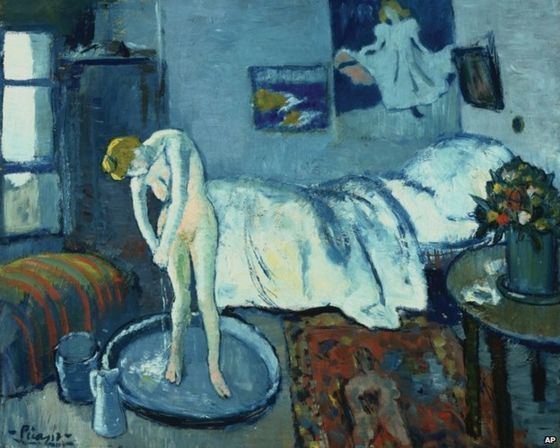Year 1901 Created 1901 | Dimensions 50 cm x 62 cm Media Oil paint | |
 | ||
Similar Pablo Picasso artwork, Picasso's Blue Period artwork, Oil paintings | ||
The Blue Room (French: La chambre bleue) is a 1901 painting by Pablo Picasso painted during his Blue Period. It was found to have a different painting hidden under it using X-ray technology in 2014 by a group of art historians and scientists from the Phillips Collection in Washington, assisted by scientists from the Cornell University High Energy Synchrotron Source.
Contents
- Hidden portrait beneath picasso s the blue room but who is he
- Painting qualities
- Hidden painting
- Possible conclusions
- References
Hidden portrait beneath picasso s the blue room but who is he
Painting qualities
In The Blue Room we can see Picasso’s blue period being fully developed. His cool hues and strong use of natural light draws the viewer in to see this young idealized woman bathing in a tub in what we can assume is her bedroom. Although the painting could be described as patchy or mildly unclear, the subject and scene are still identifiable. The woman's figure and small studio background are typical of Picasso's blue period, as seen in other works such as The Blind Man’s Meal (1903).
Hidden painting
Although this piece can be considered typical of Picasso’s early blue period works, something interesting has come up in the last few years concerning this piece. Using x-ray cameras, scientists from the Phillip’s Collection in Washington discovered another painting just underneath the surface: a portrait of an old man resting his head in his hands.
Possible conclusions
This discovery leads to the more important question, not who is this but why would Picasso do this? Historians collectively have collected biographical information regarding Picasso and his life during his Blue Period and concluded that he most likely did this because of his prolificacy in painting but lack of extra canvases. His economic state would not have allowed him to purchase the many materials needed in order to be a full-time artist. His “melancholy blue portraits” did not result in many eager buyers or people willing to pay for the portraits he created of random people off the street. Because of this, Picasso painted over several of his works until one would sell, making him some money to purchase more materials.
